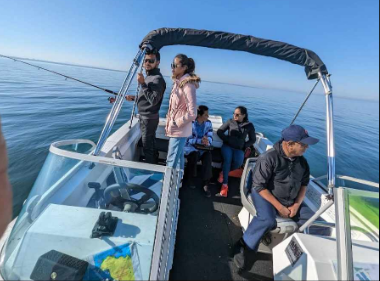Safety Tips to Go Boating
No matter how much experience you have, it’s always important for everyone to review safety rules before before go boating heading out to the water. Here are some basic safety tips that will help you and your passengers stay safe:
Be Weather-Wise
Utilize BOM.GOV.AU’s weather reporting METEYE before departure. Since Melbourne weather is ever so changing, if you notice that clouds are getting dark and if the climate suddenly drops in temperature play it safe by getting off the water.
Boat Safety Tips for Self-Driving in Port Phillip Bay
Navigating the beautiful waters of Port Phillip Bay can be an exhilarating experience, but safety should always be your top priority. Whether you’re a seasoned mariner or a novice boater, it’s essential to adhere to safety guidelines to ensure a smooth and secure journey. Here are some crucial boat safety tips for self-driving in Port Phillip Bay.
Pre-Departure Preparations
1. Check the Weather: Before setting sail, always check the weather forecast. Port Phillip Bay’s weather can change rapidly, and being aware of conditions such as wind speed, wave height, and potential storms is critical. Utilize reliable weather apps or local maritime services for up-to-date information.
2. Inspect Your Boat: Conduct a thorough inspection of your boat. Ensure that the engine, steering, and other mechanical systems are in good working order. Check for any signs of wear and tear that might need attention. Pay special attention to the fuel level and ensure you have enough for your trip.
3. Safety Equipment: Make sure all necessary safety equipment is on board and in good condition. This includes life jackets for all passengers, flares, fire extinguishers, first aid kits, and a VHF radio. Life jackets should be easily accessible and properly fitted for each person.
4. Navigation Tools: Equip your boat with proper navigation tools such as GPS, charts of the bay, and a compass. Familiarize yourself with the bay’s layout, including key landmarks, navigation markers, and potential hazards.
During Your Trip
5. Maintain a Proper Lookout: Always keep a vigilant lookout for other boats, swimmers, and potential obstacles. This is particularly important in busy areas and near marinas. Use both visual observation and radar if available.
6. Adhere to Speed Limits: Port Phillip Bay has designated speed limits, especially near the shore and in certain zones. Adhering to these limits is crucial for the safety of both your passengers and others in the vicinity.
7. Follow Navigation Rules: Understand and follow the International Regulations for Preventing Collisions at Sea (COLREGs). This includes knowing the right of way rules, proper lighting for your boat at night, and sound signals.
8. Communicate: Maintain communication with local maritime authorities and other boaters. Use your VHF radio to stay updated on any important announcements or emergencies in the area. It’s also a good practice to inform someone on land about your trip details, including your expected return time.
9. Avoid Alcohol: Operating a boat under the influence of alcohol is extremely dangerous and illegal. Alcohol impairs your judgment, reaction time, and ability to operate the vessel safely. Save the drinks for when you’re safely back on shore.
Emergency Preparedness
10. Know Your Emergency Procedures: Be prepared for emergencies by knowing how to use all safety equipment on board. Conduct regular drills with your passengers to ensure everyone knows what to do in case of a man overboard, fire, or other emergencies.
11. Stay Calm and Act Swiftly: In the event of an emergency, staying calm and acting swiftly can make all the difference. Use your VHF radio to call for help and provide clear information about your location and the nature of the emergency.
12. Check the Weather Again: Before heading back to shore, check the weather again to ensure that conditions remain safe. It’s better to delay your return trip than to risk navigating through rough weather.
Environmental Responsibility
13. Protect Marine Life: Port Phillip Bay is home to diverse marine life. Avoid disturbing wildlife by maintaining a safe distance from animals and adhering to designated no-go zones. Be mindful of your waste and dispose of it properly to protect the bay’s ecosystem.
14. Anchor Responsibly: When anchoring, choose sandy or muddy bottoms instead of coral or seagrass beds to minimize environmental impact. Ensure your anchor is securely set to prevent dragging and causing damage.
By following these boat safety tips, you can enjoy a safe and memorable experience while navigating the stunning waters of Port Phillip Bay. Prioritizing safety not only protects you and your passengers but also helps preserve the bay’s natural beauty for future generations. Happy boating!
